
The thumb is the first digit of the hand, next to the index finger. When a person is standing in the medical anatomical position, the thumb is the outermost digit. The Medical Latin English noun for thumb is pollex, and the corresponding adjective for thumb is pollical.
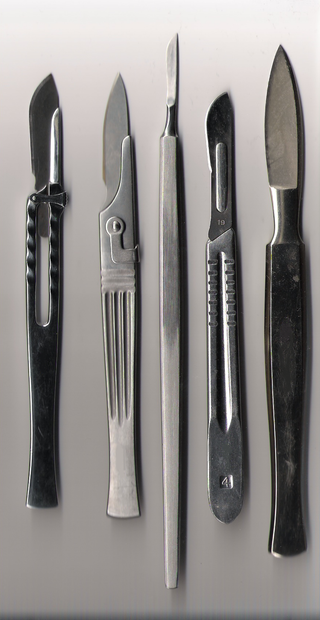
A scalpel, lancet, or bistoury is a small and extremely sharp bladed instrument used for surgery, anatomical dissection, podiatry and various handicrafts. A lancet is a double-edged scalpel.
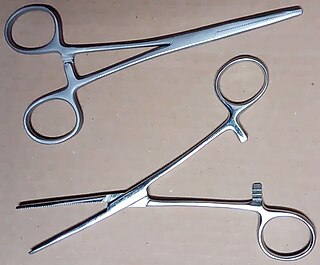
A hemostat is a tool used to control bleeding during surgery. Similar in design to both pliers and scissors, it is used to clamp exposed blood vessels shut.

Tweezers are small hand tools used for grasping objects too small to be easily handled with the human fingers. Tweezers are thumb-driven forceps most likely derived from tongs used to grab or hold hot objects since the dawn of recorded history. In a scientific or medical context, they are normally referred to as just "forceps", a name that is used together with other grasping surgical instruments that resemble pliers, pincers and scissors-like clamps.

A surgical instrument is a medical device for performing specific actions or carrying out desired effects during a surgery or operation, such as modifying biological tissue, or to provide access for viewing it. Over time, many different kinds of surgical instruments and tools have been invented. Some surgical instruments are designed for general use in all sorts of surgeries, while others are designed for only certain specialties or specific procedures.
A Pennington clamp, also known as a Duval clamp, is a surgical clamp with a triangular eyelet. Used for grasping tissue, particularly during intestinal and rectal operations. Also used in some OB/GYN procedures, particularly caesarian section. Under the name 'Duval clamp' they are occasionally used much like a Foerster clamp to atraumatically grasp lung tissue. The clamp is named after David Geoffrey Pennington, an Australian surgeon who is a pioneer of microsurgeries.
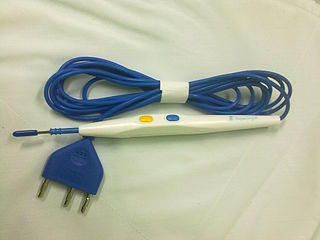
There are many different surgical specialties, some of which require very specific kinds of surgical instruments to perform.

Dental instruments are tools that dental professionals use to provide dental treatment. They include tools to examine, manipulate, treat, restore, and remove teeth and surrounding oral structures.
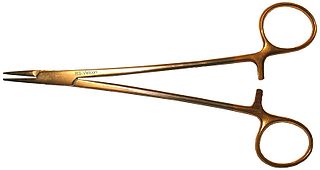
A needle holder, also called needle driver or needle forceps, is a surgical instrument similar to a hemostat, used by doctors and surgeons to hold and push a suturing needle when performing wound closure, ligation and other surgical procedures that require re-anastomosis.
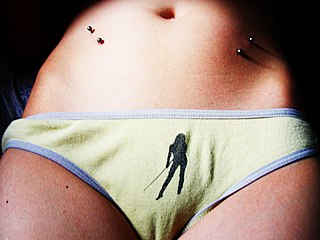
A hip piercing is a piercing in the pelvic area through the skin near the hip bone. Hip piercings are often done in couplets with one on each hip, but it is not unusual to see only one. Hips piercing are a type of surface piercing. Microdermals or skin divers can be implanted in the hip area to give a similar appearance.

A surgical suture, also known as a stitch or stitches, is a medical device used to hold body tissues together and approximate wound edges after an injury or surgery. Application generally involves using a needle with an attached length of thread. There are numerous types of suture which differ by needle shape and size as well as thread material and characteristics. Selection of surgical suture should be determined by the characteristics and location of the wound or the specific body tissues being approximated.

The following is a list of instruments that are used in modern obstetrics and gynaecology.
An end effector is the device at the end of a robotic arm, designed to interact with the environment. The exact nature of this device depends on the application of the robot.
Surgical scissors are scissors specially manufactured as surgical instruments, typically used for cutting sutures, dressings, and cutting and dissecting biological tissue. Surgical scissors are usually made of surgical steel. Some have tungsten carbide reinforcements along their cutting edges, the hardness of which allows manufacturers to create sharper and more durable edges.

Mayo scissors are a type of surgical scissor, often used in the cutting of fascia.

Circumcision surgical procedure in males involves either a conventional "cut and stitch" surgical procedure or use of a circumcision instrument or device. In the newborn period, almost all circumcisions are done by generalist practitioners using one of three surgical instruments. In the US, the Gomco clamp is the most utilized instrument, followed by the Mogen clamp and the Plastibell. They are also used worldwide.

An Allis clamp is a commonly used surgical instrument. It was invented by Oscar Allis.
No-scalpel vasectomy is a type of vasectomy procedure in which a specifically designed ringed clamp and dissecting hemostat is used to puncture the scrotum to access the vas deferens. This is different from a conventional or incisional vasectomy where the scrotal opening is made with a scalpel. The NSV approach offers several benefits, including lower risk for bleeding, bruising, infection, and pain. The NSV approach also has a shorter procedure time than the conventional scalpel incision technique. Both approaches to vasectomy are equally effective. Because of the inherent simplicity of the procedure it affords itself to be used in public health programs worldwide. This method is used in over 40 countries for male sterilisation.

The Hartmann alligator forceps or Hartmann foreign body forceps, named after the German physician Arthur Hartmann, are medical forceps for removing foreign bodies. It is used in addition to surgery mainly in otorhinolaryngology (ENT). Their quality depends on the origin and quality of the stainless steel. Indian steel is used often for hobbyist use. FDA and CE certified instruments also veterinary instruments are normally made of Japanese or German steel.

Ancient Roman surgical practices developed from Greek techniques. Roman surgeons and doctors usually learned through apprenticeships or studying. Ancient Roman doctors such as Galen and Celsus described Roman surgical techniques in their medical literature, such as De Medicina. These methods encompassed modern oral surgery, cosmetic surgery, sutures, ligatures, amputations, tonsillectomies, mastectomies, cataract surgeries, lithotomies, hernia repair, gynecology, neurosurgery, and others. Surgery was a rare practice, as it was dangerous and often had fatal results. To perform these procedures, they used tools such as specula, catheters, enemas, bone levers, osteotomes, phlebotomes, probes, curettes, bone drills, bone forceps, cupping vessels, knives, scalpels, scissors, and spathas.



















